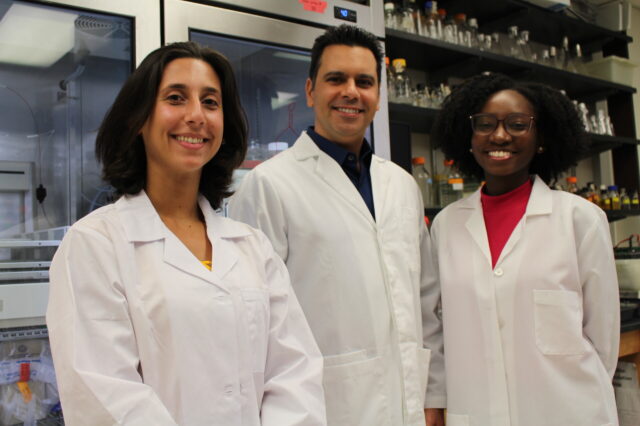UF researchers repurpose a pesticide as an antibiotic to kill deadly bacteria

From left: Isabelle M. Llabona, Dr. Aria Eshraghi and Ashley Clarke are shown in Eshraghi's lab. Llabona and Clarke, both University of Florida students, participated in a research project that resulted in a paper in Microbiology Spectrum.
University of Florida researchers have made the surprise discovery that a drug used commonly as a pesticide worldwide inhibits the growth of a highly infectious bacterial pathogen that causes a disease known as tularemia, which infects animals and people.
Caused by the pathogen known as Francisella tularensis, tularemia — also known as rabbit fever — is usually found in animals, especially rodents, rabbits and hares, according to the CDC. Typically found in rural areas, the disease has been reported in all U.S. states except Hawaii. People usually become infected through the bite of infectious animals, most often ticks and biting flies, but cases also have resulted from inhaling airborne bacteria and from laboratory accidents.
About 200 human cases of tularemia are reported each year in the United States.
Francisella tularensis is one of six biological agents listed by the Centers for Disease Control and Prevention as posing a risk to national security due to its ease of transmission and dissemination, potential for high mortality rates, public health impact and other factors.
“Species of Francisella (fran-sis-sell-uh) are among the most virulent bacteria known to humankind,” said Aria Eshraghi, Ph.D., lead author on a paper that appears in Microbiology Spectrum and an assistant professor at UF’s College of Veterinary Medicine who studies bacterial virulence and toxins. “My group discovered that an existing drug that is in use as a pesticide, tolfenpyrad, blocks the growth of these bacteria.”
A broad-spectrum insecticide and a miticide, tolfenpyrad was first approved over 20 years ago in Japan, and was first registered by the U.S. Environmental Protection Agency for greenhouse use in 2010. It was approved for outdoor use in vegetable, fruit and row crops in the United States in 2013.
The discovery came about when Eshraghi, whose research focuses on Francisella, assigned a project to a few enthusiastic trainees working in his laboratory over the summer. He came up with an intriguing project for them but had no real expectations of what they might find.
“I said, ‘We have these libraries of existing drugs in the lab for various reasons, so why don’t you throw them on these bacteria and see what happens?’” he recalled.
The results amazed Eshraghi when he understood the implications.
“I didn’t believe the data. I said, ‘You know what, you guys made a mistake. Do it again.’ They repeated the experiment and got the same result. Then I said, ‘Maybe the people who gave this drug to us made a mistake. Order it again, from a different vendor.’”
The lab purchased the drug from a second source and tested it to see if it also inhibited the growth of Francisella.
“It turns out that this drug is a highly potent inhibitor of these bacteria,” Eshraghi said, adding that tolfenpyrad has never before been shown to have an antibacterial function.
Once the results were confirmed, the researchers tested the drug on a variety of bacteria and found that it targets Francisella — but not other bacteria. This specificity was notable, as most antibiotics have broader activity against bacteria and don’t impact just a small subset, or genus.
His laboratory’s discovery provides a new direction that researchers can take to target harmful bacteria without harming “good” bacteria that are beneficial to our health, Eshraghi added.
“As part of a bigger picture, antibiotic resistance is a major problem these days, and as scientists, we’re not doing a good job of developing new approaches to treat infections.” he said. “We need to do more, and we need to do it better.”
Eshraghi’s team is now using tolfenpyrad as a tool to better understand why Francisella bacteria are so pathogenic and are developing related drugs that are more effective and less toxic.
“Antibiotics save lives,” Eshraghi said. “These lifesaving drugs have everyday effects on the welfare of humans and animals. We live longer today and with a greater quality of life than at any time in history because of the advent of antibiotics, vaccines and public health.”
About the author
